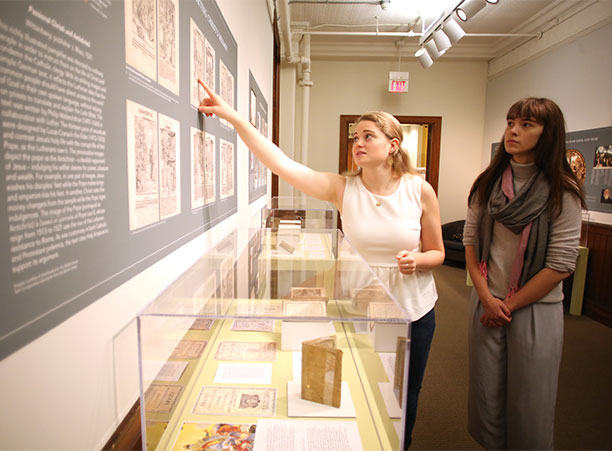 Last semester, three students assumed the role of museum curator, scanning book after book for images, visiting exhibits and contacting museums all across the world for content. The topic of their intense research was the Reformation and the result was a semester-long exhibition at the College of the Holy Cross.
Last semester, three students assumed the role of museum curator, scanning book after book for images, visiting exhibits and contacting museums all across the world for content. The topic of their intense research was the Reformation and the result was a semester-long exhibition at the College of the Holy Cross.
Titled “Fanning the Flames of Revolution: Print Culture of the Reformation,” the exhibition commemorated the 500th anniversary of Martin Luther nailing his 95 theses to the door of All Saint's Church in Wittenburg, which challenged actions of the Catholic Church and effectively launched the Reformation. The exhibition drilled into the topic further, specifically exploring how the simultaneous invention of the printing press made the dissemination of the movement’s propaganda so easy, revolutionizing communication and giving birth to mass media as we know it.
Student curators Caroline Fleming '18, Caroline MacLachlan '19, and Melody Lin '18, with Distinguished Professor of Humanities Virginia Raguin, stressed the effects the printing press had on a devoutly religious and mostly illiterate population.
“In this modern age of meme and internet culture, we take communication for granted,” says Fleming, a biology and art history double-major. “But if we reflect on what it would have been like, for a largely illiterate society, to see these images and interact with Luther's philosophies, it was absolutely revolutionary. For the first time in history, we see this hugely important political discourse reaching and including the common person, fueled by the printing press.”
Fleming’s research revealed the manipulating effects of mass media on its religious audience. Luther believed — and sought out to prove — that religious salvation can be gained through a relationship with God, not through mediation and approval from the papacy.
The Reformation tackled issues of prosperity, equality, and salvation, enticing the student curators to locate those themes in Reformation-era art for their exhibit. They quickly realized that images proved to be the easiest way for Luther to expose papal corruption and encourage meaningful dialogue about faith.
In response, the Catholic Church also decided to use religious-based images in order to negatively cast Luther and his philosophies. What ensued was a battle of images, many of which included evil characters from familiar biblical stories aimed to influence their audiences.
"You have the Catholics depicting Luther as the devil’s bagpipe, saying if you listen to Luther you are literally listening to the words of the devil," Fleming explains about some images featured in the exhibition. "Then you have Luther as the seventh headed beast from the apocalypse. They didn’t mess around; the images were really satirical."
"This is the birth of propaganda, which is crazy to me," Fleming adds. "The distribution of images, the distribution of ideas, it becomes infinitesimally greater and more influential."
Stepping back and recognizing the influence of mass media during the 16th century allowed the students to critically examine the role of communication and propaganda in today’s media — and recognize the exhibit’s application to a modern audience.
The student curators were especially mindful of the most effective way to educate people through an exhibit, with MacLachlan and Fleming simultaneously enrolled in a museum studies course. They wanted to ensure it was not too overwhelming and hoped to balance the breadth and complexity of the movement.
"I'm very wary of going to an exhibition and thinking 'Woah! This is way too much. See ya!'," says Fleming. "I wanted to make sure that this exhibition was bite sized; you don’t have to see all of the panels to totally understand it."
“It’s all about picking out things that are going to appeal to people who may not necessarily know a ton about the topic," adds MacLachlan, who is majoring in art history.
The students agree that the opportunity to curate this exhibition greatly complemented what they were learning in the classroom. While Fleming was in charge of collecting the images and writing their descriptions, MacLachlan and Lin (an art history major with minors in Asian Studies and studio art) were responsible for the design and visual appeal of the exhibition.
“I think the curating experience actually informed what we’re learning about museums studies more than how museum studies informed the exhibition,” said MacLachlan. “It’s such a by-the-moment process that involves constantly deciding what’s going to work where. That’s not something that you can teach, that’s something you have to practice.”
“We definitely want to encourage students to see career options in many branches of museum studies,” Raguin says.
A museum studies concentration is now available through the visual arts department.
Student-Curated Exhibition Explores Mass Media, Propaganda and the Reformation
Marking the 500th year anniversary, three students showcase how the Reformation — and the invention of the printing press — gave birth to mass media as we know it
Read Time
4 Minutes